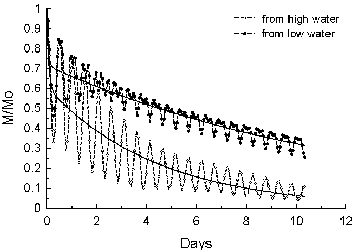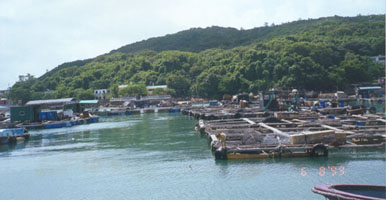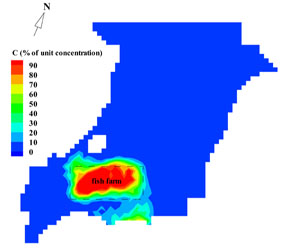Environmental Management of Mariculture
ˇ@
Investigators:
- Prof. Joseph Hun-wei Lee
- Dr. David K.W. Choi
- Dr. Feleka Arega
Coupling with Diagenetic Water Quality Model
ˇ@
Introduction
|
Marine fish culture is an important commercial practice in Hong Kong. It involves rearing of marine fish fry to marketable size in cages suspended by floating rafts. There are currently 26 designated fish culture zones occupying a total sea area of about 2.1 km2 and most of them are located in well sheltered shallow embayment. To properly manage the mariculture activities, the most practical ways are suitably sitting and stocking density control. Both of these are related to the carrying capacity of the receiving water, which is mainly governed by the flushing characteristics of the water body concerned. ˇ@ |
|
|
Floating raft
for rearing fish |
ˇ@
ˇ@
A
systematic methodology using numerical tracer experiments has been
developed to compute the tidal flushing in the fish farm. Flushing times
are determined from the results of the tracer experiment using robust
computer hydrodynamic and mass transport models. Unit tracer
concentration is initially prescribed inside the region of interest
(such as a fish farm) and zero elsewhere, then carrying out the mass
transport simulation and the mass removal process is tracked.
ˇ@
In Hong
Kong, with the influence of the freshwater discharges from the Pearl
River and the offshore oceanic currents, there is a distinct wet and dry
season hydrodynamic regime. The water column is rather well mixed in the
dry season and significantly stratified during the wet season; it is
necessary to use a three-dimensional circulation model to simulation the
tidal flow. The 3D model developed is based on a formulation similar to
the Princeton Ocean Model (POM). It solves the full 3D hydrodynamics
equations with the hydrostatic assumption. A topographically conformal
co-ordinate system is applied in the vertical direction.
ˇ@
|
|
|
Computed depth-averaged residual currents in the inner bay |
To reduce the
computational effort required, the model simulation is separated into
the external and internal modes. This allows the calculation of the free
surface elevation by solving the vertically integrated horizontal
velocity transport separately from the three-dimensional computation of
the velocity, salinity and temperature. The horizontal velocity
transport, external mode equations are obtained by integrating the full
equations over the depth and eliminating the vertical structure. They
are solved by an alternating direction implicit (ADI) five-point finite
difference scheme. The three-dimensional momentum and transport
equations are solved by a split time step scheme. Backward tracking
characteristic method is used in the advection step. Central difference
scheme is applied in the diffusion step.
ˇ@
ˇ@
|
To avoid excessive numerical dispersion and accurately simulate the mass transport, a Lagrangian particle model is developed. Forward particle tracking is used to compute the advection transport, while random walk model is employed to model the diffusion processes. |
 |
|
Variation of tracer mass in fish farm inside Three Fathoms Cove for dry season |
ˇ@
Flushing times and impacts upon ambient water
Flushing time (Tf),
defined as ˇ§the average lifetime of a particle in the given volume of
water bodyˇ¨, characterizes the effectiveness of removing the pollutants
to clean surrounding water. It is found that it is necessary to define
both "local" and "system-wide" flushing time. Based on the computed time
variations of tracer mass in the fish farm and the specific water
system, the flushing times can be computed. Also, from the predicted
tracer concentration distribution can be used to examine the
environmental impacts of pollution from the fish farm.
ˇ@
Coupling with Diagenetic Water Quality Model
Marine fish farm
often faces the threat of severe dissolved oxygen depletion due to
eutrophic conditions. Diagenetic water quality model simulating the
sediment-water-pollutant interaction is developed to address the
response of benthic layer to mariculture pollution discharges. With the
flushing rate and tidal exchanges reliably determined, the diagenetic
model will be used to determine the quasi-steady long-term average water
quality in the marine fish farm. Hence, it can be employed to assess the
carrying capacity of the fish farm.
ˇ@
|
|
|
| Predicted tracer concentrations for releasing at high water in dry season | Predicted tracer concentrations for releasing at high water in wet season |
ˇ@
ˇ@



